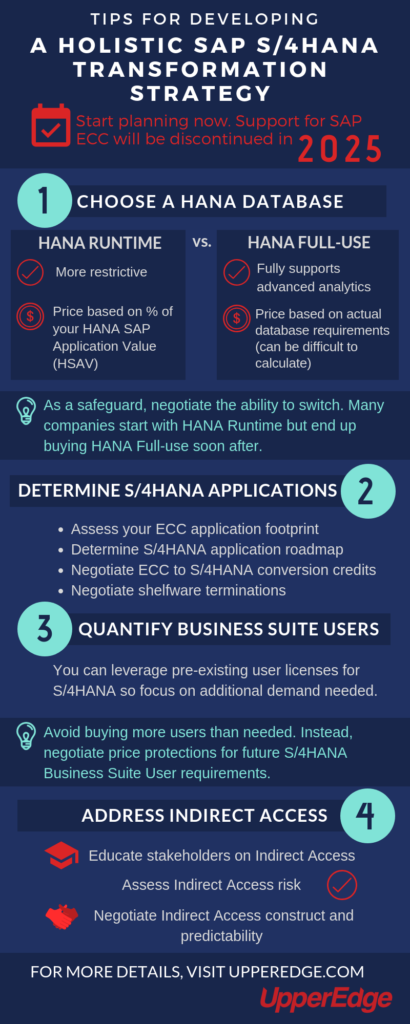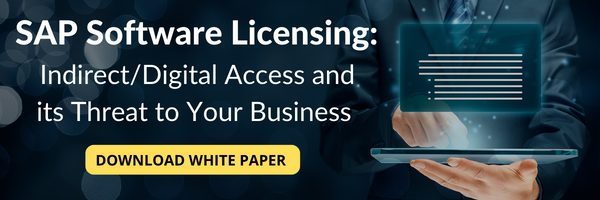- UpperEdge
- Reading Time: 5 minutes

As 2025 approaches, many companies are developing their S/4HANA transformation strategies through self-education, battle-scarred peers, and interactions with SAP – understanding, of course, that every SAP interaction eventually comes with a price. However, your S/4HANA transformation strategy must be holistic enough to include all aspects of your eventual S/4HANA environment including the database, applications, users, and of course, Indirect Access.
Conducting foundational assessments of each layer will ultimately lead to educated decision-making and highly competitive forward-looking commercial constructs.
Blog continued below….
1. HANA Database
- Assess Each HANA Database’s Capabilities and Pricing
Based on SAP’s understanding of a company’s requirements, they will position one of two options, HANA Runtime or HANA full-use. Unless prompted, SAP will not typically provide visibility into the functionality differences between HANA Runtime and HANA full-use. However, in its simplest sense HANA Runtime, which is typically positioned by SAP, is much more restrictive and does not fully support advanced analytics which many companies intend to leverage in the long-term to remain competitive. This means that you may buy HANA Runtime first and subsequently end up buying HANA full-use to leverage the less restrictive and fully supported advanced analytics of the HANA database.
Beyond functional differences, pricing between the two databases is also not typically provided. HANA Runtime is priced based on a percentage of your HANA SAP Application Value (“HSAV”) (with varying costs for HANA Runtime and HANA Runtime for Applications and BW) and HANA full-use is priced on your actual GB requirements. This means that HANA Runtime acts as a tax on all previous and future SAP investments and HANA full-use is based on your actual database requirements, which is difficult for some customers to calculate, leading to the selection of HANA Runtime as the interim database solution.
- Determine HANA Database and Negotiate Flexibility
Once an understanding of each HANA database’s capabilities and pricing are established, it is much easier to make an educated decision on which HANA database makes sense for your company. In my experience, many companies start their S/4HANA journey with HANA Runtime and end up buying HANA full-use shortly thereafter. If this is your situation or you anticipate starting with HANA Runtime, I recommend negotiating flexibility to switch to HANA full-use along with a credit, if needed.
2. S/4HANA Applications
- Assess Current ECC Application Footprint
Prior to engaging with SAP on your S/4HANA roadmap and transformation journey, start by getting a ‘lay of the land’ of your ECC application footprint. More specifically, you will need an understanding of what applications and how many units your company has purchased; what applications and how many of your entitlements you are leveraging today; and what applications and how many entitlements you anticipate using in the future. This is a critical step in the process, allowing you to come to the negotiation table with a current and future state understanding of your SAP ECC application landscape, which ultimately translates to cost-cutting levers that can be pulled during the course of your S/4HANA negotiations.
- Inform S/4HANA Roadmap & Negotiate Cost-Cutting Levers
With a current and future state understanding of your SAP ECC application landscape, I would recommend leveraging this intelligence to inform your S/4HANA roadmap and associated cost-cutting levers. First and foremost, SAP has been willing to provide customers with conversion credits to make the migration from ECC to S/4 more palatable from a software and maintenance perspective. Therefore, I would recommend positioning ECC to S/4 conversion credits with SAP along with visibility into calculations and what ECC applications will ultimately be terminated.
Above and beyond ECC to S/4 conversion credits, SAP has been willing to provide the ability to terminate shelfware during strategic negotiations which ultimately reduces ongoing maintenance. Therefore, I would recommend leveraging this inflection point to terminate the applications you do not use or plan to use in the future. This will provide some relief on your ongoing maintenance as you plan to add additional S/4HANA applications to your SAP application landscape.
3. Business Suite Users
- Assess & Rationalize Current ECC User Footprint
Similar to the exercise conducted on your ECC application footprint, an assessment exercise on your user footprint will be time well spent. More specifically, developing an understanding of how many of each ECC user license your company has purchased; how many of each ECC user licenses you are leveraging today; and any opportunities to rationalize. While it may be clear how many ECC users have been purchased and are being leveraged today, what is often overlooked by companies is internally rationalizing users prior to SAP’s positioning of an audit. For example, I often see many companies run LAW reports and realize that they have assigned Professional Users when they could have assigned Limited Professionals which are significantly less expensive. This is an opportunity to rationalize the user footprint to ensure the appropriate license levels are assigned and resources are not leveraging higher-level ECC users than are necessary.
- Determine S/4HANA User Demand & Negotiate Price Protection
Once an assessment and rationalization of the current ECC user footprint has been undertaken, determine your S/4HANA user demand. For S/4HANA, specifically, you can leverage your pre-existing user licenses and therefore only need to worry about the additional demand you may have. My recommendation would be that you focus on the near-term or more immediate demand and leverage the strategic nature of your S/4HANA investment to negotiate highly competitive price protections to license additional users as you require them in the future.
4. Indirect Access
- Educate Your Company on Indirect Access and Assess Risk
Last but certainly not least, with SAP’s formal announcement earlier this year, it is evident that Indirect Access is not something that is going away. As such, I would recommend getting educated on SAP’s recent Indirect Access announcements, in-scope scenarios, out-of-scope scenarios, metrics, and pricing. Leveraging this level of intelligence, you can assess what your risk looks like today and what you anticipate it to look like in the future. This will enable your company to come to the negotiation table with a point of view on perceived risk and can ensure you are not paying more than you need to for Indirect Access now and in the future.
- Determine and Negotiate Indirect Access Construct
Leveraging the results of your self-assessment, you can determine the type of Indirect Access construct that makes the most sense for your company, along with predictable pricing. If your risk is low and will remain that way, you may choose to negotiate away additional Indirect Access risk through highly competitive price protections. On the flip side, if your risk is high and is anticipated to continue in that direction, you may choose to negotiate alternative licensing constructs to avoid Indirect Access altogether.
Considering only one or two of these aspects can enable a piecemeal approach from SAP resulting in blown budgets and disgruntled CFOs. I advocate you evaluate these four areas before you begin your SAP S/4HANA journey to put your company in a stronger position to make informed, solid decisions, leading to a holistic SAP S/4HANA transformation strategy.
Comment below and follow UpperEdge on Twitter and LinkedIn.

